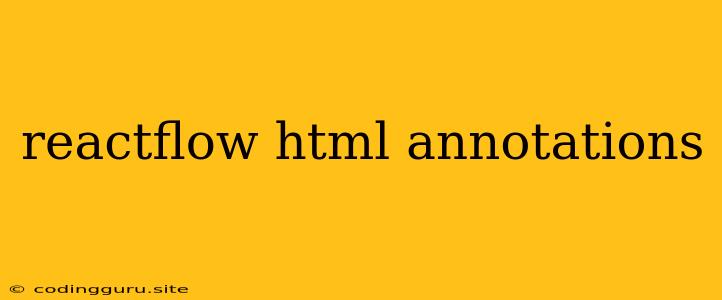ReactFlow: Enhancing Visualizations with HTML Annotations
ReactFlow, a powerful JavaScript library for building interactive node-based diagrams, offers a seamless way to integrate custom HTML annotations into your visualizations. These annotations can be used to add rich information, dynamic elements, and interactive components directly to your flow diagram, making them more engaging and informative.
Why Use HTML Annotations?
Traditionally, node-based diagrams often rely on simple text labels or basic icons to represent information. However, HTML annotations empower you to:
- Display Complex Data: Include tables, charts, images, or even forms within your nodes for a more comprehensive representation of your data.
- Create Interactive Elements: Integrate buttons, sliders, dropdowns, or other HTML elements to allow users to interact with the diagram directly.
- Provide Contextual Information: Display detailed descriptions, tooltips, or pop-up windows when a node is selected, providing users with additional insights.
- Enhance Visual Appeal: Use custom HTML styling and CSS to design annotations that align perfectly with your application's aesthetic.
Getting Started with HTML Annotations
ReactFlow provides a straightforward way to incorporate HTML annotations into your diagrams. Let's explore a practical example:
import React, { useState, useRef } from 'react';
import ReactFlow, {
addEdge,
Background,
Controls,
Handle,
Node,
useNodesState,
useEdgesState,
} from 'reactflow';
const initialNodes = [
{
id: '1',
position: { x: 100, y: 50 },
data: { label: 'Node 1', content: 'This is some content.' },
},
{
id: '2',
position: { x: 300, y: 150 },
data: { label: 'Node 2', content: 'This is more content.' },
},
];
const initialEdges = [
{ id: 'e1-2', source: '1', target: '2', type: 'smoothstep' },
];
function App() {
const [nodes, setNodes] = useNodesState(initialNodes);
const [edges, setEdges] = useEdgesState(initialEdges);
const reactFlowWrapper = useRef(null);
const onConnect = (params) => setEdges((edges) => addEdge(params, edges));
const handleNodeClick = (event, node) => {
// Display a pop-up with additional information
alert(`You clicked on ${node.data.label}`);
};
return (
))}
);
}
export default App;
In this example, we define a Node component with a custom className for styling. The dangerouslySetInnerHTML attribute allows us to dynamically inject the HTML content stored in node.data.content.
Customizing HTML Annotations
You can customize the appearance and functionality of HTML annotations using CSS and JavaScript. For example:
- Styling: Define classes or styles for the annotations to control their size, colors, fonts, and layout.
- Interactivity: Add event listeners to handle user interactions such as clicks, hovers, or drag-and-drop events.
- Data Binding: Bind HTML elements to data within your nodes to create dynamic visualizations.
Advanced Techniques
For complex annotations, consider using React components or custom hooks:
- React Components: Create reusable React components to represent your annotations, making your code more organized and maintainable.
- Custom Hooks: Utilize custom hooks to manage state and logic related to your annotations within your ReactFlow components.
Conclusion
ReactFlow's support for HTML annotations provides a powerful way to enhance your node-based diagrams with rich content, interactivity, and visual appeal. By leveraging this functionality, you can create visualizations that are not only informative but also engaging for your users. Remember to prioritize user experience and ensure your annotations enhance the overall usability of your diagrams.
